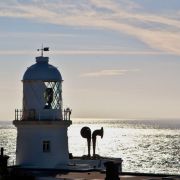The white 26-metre octagonal tower of Godrevy lighthouse was made famous by Virginia Woolfe in her novel 'To the Lighthouse', though she places it elsewhere in the book. This, the focus of her inspiration, stands on the diminutive and rocky but pretty Godrevy Island, at the centre of a circular grassy area enclosed by a low stone wall. Just over 3 miles out to sea in West Cornwall’s St Ives Bay, in stormy weather the island is exposed to the full fury of the Atlantic and it exists to warn passing vessels of the dangers of the Stones reef which stretches from Godrevy island in the direction of the town of St Ives.
It was these perilous rocks which occasioned the construction of the lighthouse in 1858, but not before many a ship and crew had been wrecked, including one in 1649 which was apparently carrying many personal effects of King Charles I, including his entire wardrobe. Given the number of casualties over the years, and no obligation to give the shipwrecked dead a proper burial until the 1800s, many an unfortunate sailor’s final resting place was simply in the dunes of the nearby beaches.
Finally, in 1854, the dramatic loss of a hefty steamer, the Nile, with all crew lost, triggered much petitioning and eventually the long-overdue building. The 3-feet thick walls are made of rubble and mortar and it took just over a year to complete. Storms over the winter of 1858 kept the builders marooned on the island for weeks at a time, and hordes of curious visitors sometimes impeded progress, but in March 1859 the Godrevy light was lit. Its dual beam warned vessels when they were nearing the reef, and a big bell served as a warning in fog.
The lighthouse was originally manned by a rotation of three keepers who would have lived, two at a time, in the adjoining cottage. In those days visitors would sometimes row themselves out to the island to visit the lighthouse and its keepers, however the cost of a manned lighthouse became untenable as shipping diminished and in the 1930s it became automatic, fuelled by solar power since 1995. Nowadays the only feet to tread the island are those of a variety of seabirds. Pipits and oyster-catchers mingle with common gulls and cormorants, and spring sees a flourish of coast-hardy flowers coat the grassy enclosure.
Despite still serving shipping traffic, the lighthouse is now simply part of the lovely view from the beaches which surround St Ives bay. Mainland Godrevy beach itself is owned by the National Trust and boasts a café, a decent surfing wave and regular visitors in the shape of seals.






